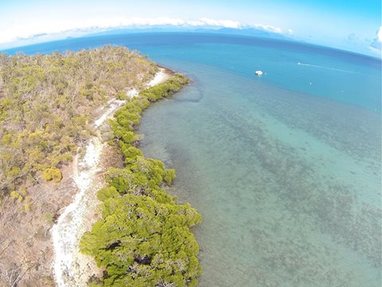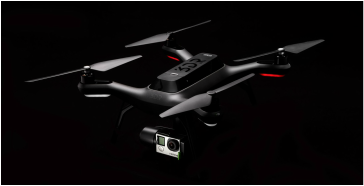 If the camera had been doing as it was told (i.e. pointing down), I wouldn't have this amazing shot
If the camera had been doing as it was told (i.e. pointing down), I wouldn't have this amazing shot Last week I spent an entire day trying to sort out my Iris+ with Tarot gimbal / Go Pro setup. Yes, it's supposed to be plug and play. And it sort of was. Just not play properly. The issue I had was widely noted on the net: the camera / gimbal 'shuddered' and would not hold a position. Generally I could get it pointed straight down, or straight out, but nothing in between. And then in flight, it would randomly switch between down or out angle - perhaps it thought it could choose the camera angle better than I could! Indeed, there were some nice horizon shots!
So back in the lab, I went back to the beginning to install and configure the gimbal. The reason I wasted so much time was because some of the websites that I visited had incorrect advice. Imagine that!
Rather than write an entire user guide, I've collated what I found out to work for me:
How to install the Tarot gimbal:
This is the best site to use. There are several, many with incorrect advice (including the 3dr official site!).
Make sure that you get the gimbal connection right! The connection shown here in step 3 is INCORRECT. The black wire needs to go to the pin on the bottom right of the picture, not the middle one. Thanks 3DR, this was one of my biggest problems - in this configuration the gimbal would not respond to the RC after the firmware upgrade at all. Weird that it responded beforehand though...
If the gimbal shudders (mine did!), upgrade the gimbal firmware as per above best site. Note the importance of NOT connecting to the power source until AFTER you start the upgrade. Weird hey. It's shown perfectly in the video below.
When trying to configure the gimbal, if you get a prolific USB to serial error, follow the directions on this page. I tried links from other pages as well but they didn't work. This was definitely the best one.
Once you've done all this, if the camera is not pointing in the correct direction, you need to re-calibrate it. Point it straight upwards towards the belly of the platform. Click on 'calibrate sensor'. This is shown in the video below as well.
If I had used the ardupilot wiki in the first place, then I would have saved myself a lot of time! For those sifting through the sea of advice on this matter, hopefully this confirms for you which recommendations to follow.
So back in the lab, I went back to the beginning to install and configure the gimbal. The reason I wasted so much time was because some of the websites that I visited had incorrect advice. Imagine that!
Rather than write an entire user guide, I've collated what I found out to work for me:
How to install the Tarot gimbal:
This is the best site to use. There are several, many with incorrect advice (including the 3dr official site!).
Make sure that you get the gimbal connection right! The connection shown here in step 3 is INCORRECT. The black wire needs to go to the pin on the bottom right of the picture, not the middle one. Thanks 3DR, this was one of my biggest problems - in this configuration the gimbal would not respond to the RC after the firmware upgrade at all. Weird that it responded beforehand though...
If the gimbal shudders (mine did!), upgrade the gimbal firmware as per above best site. Note the importance of NOT connecting to the power source until AFTER you start the upgrade. Weird hey. It's shown perfectly in the video below.
When trying to configure the gimbal, if you get a prolific USB to serial error, follow the directions on this page. I tried links from other pages as well but they didn't work. This was definitely the best one.
Once you've done all this, if the camera is not pointing in the correct direction, you need to re-calibrate it. Point it straight upwards towards the belly of the platform. Click on 'calibrate sensor'. This is shown in the video below as well.
If I had used the ardupilot wiki in the first place, then I would have saved myself a lot of time! For those sifting through the sea of advice on this matter, hopefully this confirms for you which recommendations to follow.

 RSS Feed
RSS Feed
